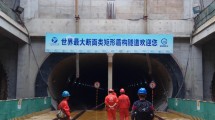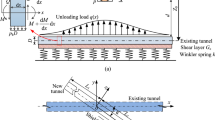Abstract
The ground movement induced by the construction of shield tunnels affects the safety of nearby underground pipes and aboveground structures. Therefore, the reliable prediction of ground movement is important. In this paper, a model describing the interaction between soil and an EPB shield used in tunnels is presented, based on the classical elastic theory of Mindlin. In this model, the changing location of the working shield is considered. The equations describing the ground deformation around the tunnel caused by the additional force on the shield working surface and the frictional force between the outer surface of the shield and the surrounding soil are derived. The ground deformation caused by ground loss due to shield tunnel construction is derived using stochastic medium theory. Finally, this model is applied to two running tunnels, and the sensitivity of the ground deformation to the calculation parameters is discussed.
Similar content being viewed by others
References
Antonio Bobet (2001). “Analytical solutions for shallow tunnels in saturated ground.” Journal of Engineer Mechanics, Vol. 127, No. 12, pp. 1258–1266. DOI: 10.1061/(ASCE)0733-9399(2001)127:12(1258).
Attewell, P. B. (1977). “Ground movements caused by tunneling in soil.” Conference on Large Ground Movements and Structure, Wiley, New York, pp. 812–948.
Chakeri Hamid, Ozcelik Yilmaz, and Unver Bahtiyar (2013). “Effects of important factors on surface settlement prediction for metro tunnel excavated by EPB.” Tunnelling and Underground Space Technology, Vol. 36, No. 6, pp.14–23, DOI: 10.1016/j.tust.2013. 02.002.
China Railway Tunnel Stock co., LTD. (2003). “The survey and geological data of tunnel and ground surface in the Xu-Nan running tunnel in Nanjin.” (in Chinese)
Federico Pinto and Andrew J. Whittle (2014). “Ground Movements due to Shallow Tunnels in Soft Ground: 1. Analytical Solutions.” Journal of Geotechnical and Geoenvironmental Engineering, Vol. 140, No. 4, DOI: 10.1061/(ASCE) GT. 1943-5606.0000948.
Gordon, T. C., Kung, C., Hsein Juang, M. ASCE, Evan C. L. Hsiao, Youssef M. A., and Hashash (2007). “Simplified model for wall deflection and ground-surface settlement caused by braced excavation in clays.” Journal of Geotechnical and Geoenvironmental Engineering, Vol. 133, No. 6, pp. 731–747, DOI: 10.1061/(ASCE)1090-0241(2007) 133:6(731).
Hu Xin and Huang Hong-wei (2001). “Mechanical analysis of superimposed load introduced by propulsion of adjacent parallel pipe.” Rock and Soil Mechanics, Vol. 22, No. 1, pp. 75–77. (in Chinese)
Huang Maosong, Zhang Chenrong, and Li Zao (2009). “A simplified analysis method for the influence of tunneling on grouped piles.” Tunnelling and Underground Space Technology, Vol. 24, No. 4, pp. 410–422, DOI: 10.1016/j.tust.2008.11.005.
Kim, C. Y., Bae, G. J., Hong, S. W., Park, C. H., Moon, H. K., and Shin, H. S. (2001). “Neural network based prediction of ground surface settlements due to tunneling.” Computers and Geotechnics, Vol. 28, Nos. 6-7, pp. 517–547, DOI: 10.1016/S0266-352X(01)00011-8.
Li Wenxiu, Li Jifei, Wang Qi, Xia Yin, and Ji ZhanHua (2012). “SMTGP method of prediction for ground subsidence due to tunneling in mountainous areas.” Tunnelling and Underground Space Technology, Vol. 32, No. 12, pp. 198–211, DOI: 10.1016/j.tust.2012.06.012.
Liu Baochen (1993). “Ground surface movement due to underground excavation in P. R. China.” Comprehensive Rock Engineering, New York: Pergaman Press, pp. 781–817.
Liu Hong-zhou and SUN Jun (2002). “Analysis on reasons and influenced factors of stratum subsidence caused by earth pressure balance shield.” Rock and Soil Engineering, Vol. 23, No. 2, pp. 5–9. (in Chinese)
Litwiniszyn, J. (1957). “The theories and model research of movements of ground masses.” In: Proceedings of European Congress Ground Movement, Leeds, UK, pp. 203–209.
Loganathan, N. and Poulos, H. G. (1998). “Analytical prediction for tunneling-induced ground movements in clays.” Journal of Geotechnical and Geoenvironmental Engineering, Vol. 124, No. 9, pp. 846–856, DOI: 10.1061/(ASCE)1090-0241(1998)124: 9(846).
Mahmoud Ahmed, Magued Iskander (2011). “Analysis of tunnelinginduced ground movements using transparent soil models.” Journal of Geotechnical and Geoenvironmental Engineering, Vol. 137, pp. 525–535, DOI: 10.1061/(ASCE)GT.1943-5606.0000456.
Mindlin Raymond D. (1936). “Force at a point in the interior of a semiinfinite solid.” Physics, Vol. 7, pp. 195–202.
Moorak Son, Edward J. Cording, and M. ASCE. (2005). “Estimation of building damage due to excavation-induced ground movements.” Journal of Geotechnical and Geoenvironmental Engineering, Vol. 131, No. 2, pp. 162–177, DOI: 10.1061/(ASCE)1090-0241(2005) 131:2(162).
New, B. M. and O’Reilly, M. P. (1992). “Tunneling-induced ground movements, predicting their magnitude and effects.” Proceedings of the 4th Conference On Ground Movements and Structures, Pentech Press, London. pp. 671–697.
Nomoto T., Mori H., and Matsumoto, M. (1995). “Overview of ground movement during shield tunneling.” A survey on Japanese shield tunneling. in: Fujita & Kusakabe eds. Proc. Underground Construction in Soft Ground, Balkema, Rotterdam, pp. 345–351.
Osman, A. S., Bolton, M. D., and Mair, R. J. (2006). “Predicting 2D ground movement around tunnels in undrained clay.” Geotechnique, Vol. 56, No. 9, pp. 597–604, DOI: 10.1680/geot.2006.56.9.597.
Peck, R. B. (1969). “Deep excavation and tunneling in soft ground.” State of the Art Report. Proc. 7Int. Conf. On Soil Mechanics and Foundation Engineering, Mexico City, pp. 225–290.
Peng FangLe, Wang HaiLin, Tan Yong, Xu Zhengliang, and Li Yaoliang (2011). “Field measurements and finite-element method simulation of a tunnel shaft constructed by pneumatic caisson method in shanghai soft ground.” Journal of Geotechnical and Geoenvironmental Engineering, Vol. 137, No. 5, pp. 516–524, DOI: 10.1061/(ASCE)GT.1943-5606.0000460.
Sagaseta, C. (1987). “Analysis of undrained soil deformation due to ground loss.” Geotechnique, Vol. 37, pp. 301–320.
Shi Chenghua, Peng Limin (2004). “Application of stochastic medium theory to predicting settlement in longitudinal surface due to tunnel construction by shield.” Rock and Soil Mechanics, Vol. 25, No. 2, pp. 320–323. (in Chinese)
Shi, C. H., Cao, C. Y., Peng, L. M., Lei, M. F., and Ai, H. J. (2016). “Effects of lateral unloading on the mechanical and deformation performance of shield tunnel segment joints.” Tunnelling and Underground Space Technology, Vol. 51, No. 1, pp.175–188, DOI: 10.1016/j.tust.2015. 10.033.
Sun, H. S., Lei, G. H., and Ng, C. W. W. (2013). “Displacements under linearly distributed pressures by extended Mindlin’s equations.” Computers and Geotechnics, Vol. 50, pp. 143–149, DOI: 10.1016/j.compgeo.2013.01.009.
Suwansawat Suchatvee and Einstein H. Herbert (2006). “Artificial neural networks for predicting the maximum surface settlement caused by EPB shield tunneling.” Tunnelling and Underground Space Technology, Vol. 21, No. 2, pp. 133–150, DOI: 10.1016/j.tust.2005.06.007.
Verruijt, A. and Booker, J. R. (1996). “Surface settlements due to deformation of a tunnel in an elastic half plane.” Geotechnique, Vol. 46, No. 4, pp. 753–756.
Verruijt, A. (1998). “Deformations of an elastic half plane with a circular cavity.” International Journal of Solids Structures, Vol. 35, No. 21, pp. 2795–2804, DOI: 10.1016/S0020-7683(97)00194-7.
Wei Gang and Wei Xin-jiang (2006). “Analysis of superimposed load induced by propulsion of adjacent level parallel pipe-jacking.” Rock and Soil Mechanics, Vol. 27, No. 11, pp. 1992–1996. (in Chinese)
Yang, J. S., Liu, B. C., and Wang, M. C. (2004). “Modeling of tunnelinginduced ground surface movements using stochastic medium theory.” Tunnelling and Underground Space Technology, Vol. 19, No. 2, pp. 112–123, DOI: 10.1016/j.tust.2003.07.002.
Yang X. L. and Wang, J. M. (2011). “Ground movement prediction for tunnels using simplified procedure.” Tunnelling and Underground Space Technology, Vol. 26, No. 3, pp. 462–471, DOI: 10.1016/j.tust.2011.01.002.
Zhang Zhiguo, Huang Maosong, and Zhang Mengxi (2011). “Theoretical prediction of ground movements induced by tunneling in multilayered soils.” Tunnelling and Underground Space Technology, Vol. 26, No. 2, pp. 345–355, DOI: 10.1016/j.tust.2010.11.005.
Zhu Zhong-long, ZHANG Qing-he, and YI Hong-wei (2001). “Stochastic theory for predicting longitudinal settlement in soft-soil tunnel.” Rock and Soil Mechanics, Vol. 22, No. 6, pp. 56–59. (in Chinese)
Author information
Authors and Affiliations
Corresponding author
Rights and permissions
About this article
Cite this article
Shi, C., Cao, C. & Lei, M. An analysis of the ground deformation caused by shield tunnel construction combining an elastic half-space model and stochastic medium theory. KSCE J Civ Eng 21, 1933–1944 (2017). https://doi.org/10.1007/s12205-016-0804-y
Received:
Accepted:
Published:
Issue Date:
DOI: https://doi.org/10.1007/s12205-016-0804-y




